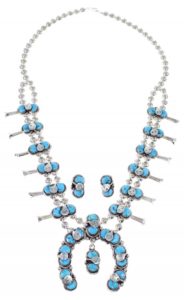
The history of the Native American squash blossom is a combination of Spanish culture and Native American creativity. The piece was once a proud cultural art form for the Spanish and soon became more known as a Native American art after they adopted it and made it their own through incorporating Northern American stones and precious metals.
Many Native American artists use their talent to work traditional Native symbols into the pieces, through various silversmith techniques.
One such symbol is the snake. While this may seem like an ill-omen in many modern western cultures, due to the snake’s malicious nature, Native Americans have adopted a different view on the subject. This symbol is actually a positive sign. The snake is a sign of rebirth and good luck. This is taken from the concept of a snake shedding its skin and being “reborn” anew.
By incorporating this symbol as a snake squash blossom necklace, the wearer of these pieces can embody these attributes too. Wearing symbols in this manner and attaining power is a long-standing belief among many tribes.
People that wear the snake squash blossom necklace can embody the crafty spirit of the snake. Protecting them from illness and allowing them to shed their skin and be born again. The symbol is also believed to be associated with healing.
The most common way for artists to incorporate these symbols into their art is by changing the basic shape of pedals that line the sides of the main pendant, into the symbol itself. They can also change the center pendant into the symbol, as long as it still maintains the same squash blossom shape.
Snake squash blossom necklaces are a great celebration of Native American art, history, and culture and serve as a way to honor the past and language of the Native community.
